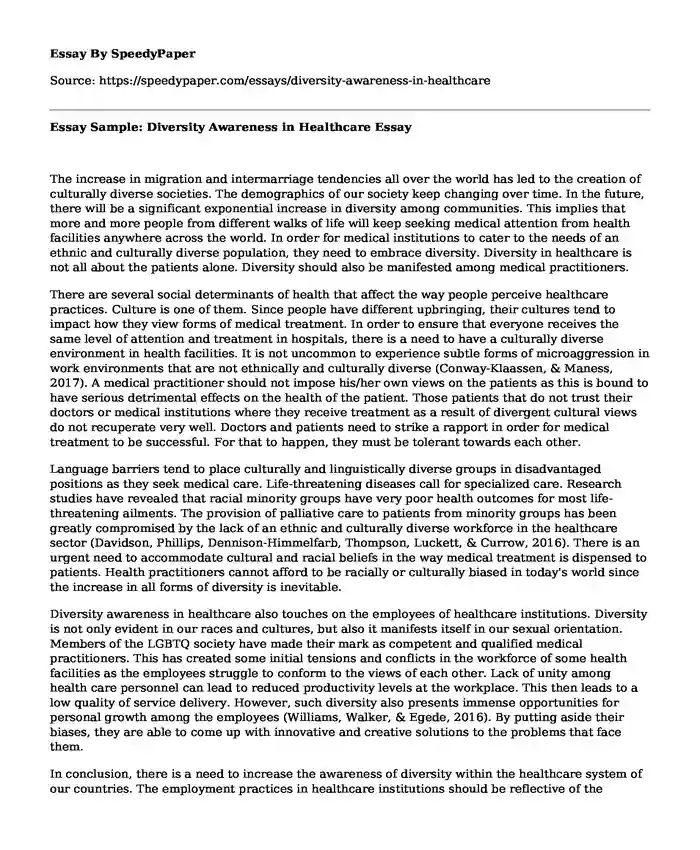
| Type of paper: | Essay |
| Categories: | Immigration Healthcare Multiculturalism Diversity Public health |
| Pages: | 3 |
| Wordcount: | 721 words |
The increase in migration and intermarriage tendencies all over the world has led to the creation of culturally diverse societies. The demographics of our society keep changing over time. In the future, there will be a significant exponential increase in diversity among communities. This implies that more and more people from different walks of life will keep seeking medical attention from health facilities anywhere across the world. In order for medical institutions to cater to the needs of an ethnic and culturally diverse population, they need to embrace diversity. Diversity in healthcare is not all about the patients alone. Diversity should also be manifested among medical practitioners.
There are several social determinants of health that affect the way people perceive healthcare practices. Culture is one of them. Since people have different upbringing, their cultures tend to impact how they view forms of medical treatment. In order to ensure that everyone receives the same level of attention and treatment in hospitals, there is a need to have a culturally diverse environment in health facilities. It is not uncommon to experience subtle forms of microaggression in work environments that are not ethnically and culturally diverse (Conway-Klaassen, & Maness, 2017). A medical practitioner should not impose his/her own views on the patients as this is bound to have serious detrimental effects on the health of the patient. Those patients that do not trust their doctors or medical institutions where they receive treatment as a result of divergent cultural views do not recuperate very well. Doctors and patients need to strike a rapport in order for medical treatment to be successful. For that to happen, they must be tolerant towards each other.
Language barriers tend to place culturally and linguistically diverse groups in disadvantaged positions as they seek medical care. Life-threatening diseases call for specialized care. Research studies have revealed that racial minority groups have very poor health outcomes for most life-threatening ailments. The provision of palliative care to patients from minority groups has been greatly compromised by the lack of an ethnic and culturally diverse workforce in the healthcare sector (Davidson, Phillips, Dennison-Himmelfarb, Thompson, Luckett, & Currow, 2016). There is an urgent need to accommodate cultural and racial beliefs in the way medical treatment is dispensed to patients. Health practitioners cannot afford to be racially or culturally biased in today's world since the increase in all forms of diversity is inevitable.
Diversity awareness in healthcare also touches on the employees of healthcare institutions. Diversity is not only evident in our races and cultures, but also it manifests itself in our sexual orientation. Members of the LGBTQ society have made their mark as competent and qualified medical practitioners. This has created some initial tensions and conflicts in the workforce of some health facilities as the employees struggle to conform to the views of each other. Lack of unity among health care personnel can lead to reduced productivity levels at the workplace. This then leads to a low quality of service delivery. However, such diversity also presents immense opportunities for personal growth among the employees (Williams, Walker, & Egede, 2016). By putting aside their biases, they are able to come up with innovative and creative solutions to the problems that face them.
In conclusion, there is a need to increase the awareness of diversity within the healthcare system of our countries. The employment practices in healthcare institutions should be reflective of the demographics of the country. This will enable all and sundry to receive equal access to healthcare services. It will also ensure that the workplace environment is devoid of any forms of racial, ethnic and sexual discrimination.
References
Conway-Klaassen, J., & Maness, L. (2017). Critical conversations: Cultural awareness, sensitivity, and competency. American Society for Clinical Laboratory Science, 30(1), 34-37.Retrieved from (http://clsjournal.ascls.org/content/30/1/34)
Davidson, P. M., Phillips, J. L., Dennison-Himmelfarb, C., Thompson, S. C., Luckett, T., & Currow, D. C. (2016). Providing palliative care for cardiovascular disease from a perspective of sociocultural diversity: a global view. Current opinion in supportive and palliative care, 10(1), 11-17. Retrieved from (https://journals.lww.com/co-supportiveandpalliativecare/fulltext/2016/03000/Providing_palliative_care_for_cardiovascular.7.aspx)
Williams, J. S., Walker, R. J., & Egede, L. E. (2016). Achieving equity in an evolving healthcare system: opportunities and challenges. The American journal of the medical sciences, 351(1), 33-43. Retrieved from (https://www.sciencedirect.com /science/article/abs/pii/S0002962915000129)
Cite this page
Essay Sample: Diversity Awareness in Healthcare. (2023, Jan 08). Retrieved from https://speedypaper.net/essays/diversity-awareness-in-healthcare
Request Removal
If you are the original author of this essay and no longer wish to have it published on the SpeedyPaper website, please click below to request its removal:
- Sadie Pfeiffer, Spinner in Cotton Mill - Free Essay on the Picture by Lewis Hine
- Free Essay on Budgeting Money
- Article Review Essay Example about Behavioral Intervention in Autistic Children
- Free Essay: Chinese Herbal Medication Interaction with Prescribed Drugs: A Case of Ephedra
- Essay Example: Blood Vessels, Lymphatic and Immune System
- Essay Example - DateTechnology Regulation
- Essay Sample on The Challenges Faced by Personnel from Cuba
Popular categories




